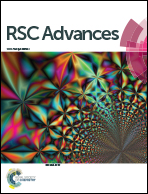Synthesis and characterization of the thermodynamic and electrochemical properties of tetra-alkyl phosphonium oxalate ionic liquids†
Abstract
Ionic liquids (ILs) are attractive alternatives to water, high temperature molten salts or conventional organic solvents for electrodeposition of technologically important metals. Designing ILs containing functional groups specifically targeted to interact with or even chelate metals, such as carboxylate, may increase the metal solubility and affect thermodynamic and electrochemical properties. This paper reports the synthesis and characterization of three ionic liquids comprised of one or two tetra-alkyl phosphonium cations paired with a hydrogen oxalate or oxalate anion, with the general formula [(PRRRR′)x][C2O4H2−x], R = 4,6 and R′ = 4, 14. These compounds were characterized by 1H, 13C, 31P NMR, and Raman spectroscopy. Electrochemical windows, electrical conductivities, densities and viscosities were also determined experimentally. Thermal gravimetric analysis (TGA) revealed decomposition temperatures above 200 °C and differential scanning calorimetry (DSC) analysis revealed that the two [(P66614)x][C2O4H2−x] salts have similar glass transition temperatures while [(P4444)2][C2O4] has a melting point above room temperature. Raman and powder X-ray diffraction spectroscopy confirm that Nd2O3 dissolves and complexes with [P66614][C2O4].


 Please wait while we load your content...
Please wait while we load your content...